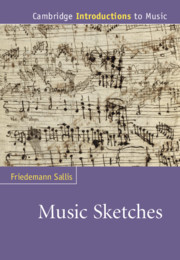Book contents
- Frontmatter
- dedication
- Contents
- List of figures
- List of music examples
- List of tables
- Preface
- Chapter 1 Introduction
- Chapter 2 Sketch studies past and present
- Chapter 3 Tracking down evidence of the creative process
- Chapter 4 The physical objects of the compositional process
- Chapter 5 Studying loose leaves
- Chapter 6 Sketchbooks
- Chapter 7 Transcription and facsimile reproduction
- Chapter 8 Sketches and the critical edition of music
- Chapter 9 Dangerous liaisons: the evolving relationship between sketch studies and analysis
- Chapter 10 Musical palimpsests and authorship
- Appendix: Beethoven sketchbooks published between 1913 and 2013
- Notes
- Glossary
- Bibliography
- Index
Chapter 5 - Studying loose leaves
Published online by Cambridge University Press: 05 February 2015
- Frontmatter
- dedication
- Contents
- List of figures
- List of music examples
- List of tables
- Preface
- Chapter 1 Introduction
- Chapter 2 Sketch studies past and present
- Chapter 3 Tracking down evidence of the creative process
- Chapter 4 The physical objects of the compositional process
- Chapter 5 Studying loose leaves
- Chapter 6 Sketchbooks
- Chapter 7 Transcription and facsimile reproduction
- Chapter 8 Sketches and the critical edition of music
- Chapter 9 Dangerous liaisons: the evolving relationship between sketch studies and analysis
- Chapter 10 Musical palimpsests and authorship
- Appendix: Beethoven sketchbooks published between 1913 and 2013
- Notes
- Glossary
- Bibliography
- Index
Summary
The labyrinth
Making sense of the ‘bewildering sea of documents’ one often encounters in manuscript collections, is one of the more challenging tasks facing scholars studying the creative process. Identifying and classifying large quantities of unordered and often undated manuscripts is an expert’s job. Yet, as Jacques Barzun and Henry Graff have noted, the requisite skills are, more often than not, learned on the spot through trial and error. This is particularly true with regard to the study of musical sketches and drafts, a relatively recent addition to the broad, well-established field of manuscript studies to which Barzun and Graff were referring. Sorting unordered collections of loose-leaf sketch material is difficult but certainly not impossible. Success usually requires that the scholar bring together different types of information gleaned from the evaluation of the documents as physical objects (codicology), the study of the writing (palaeography) and the examination of the content of the written text. The combination of data from these different perspectives can open up numerous paths through the labyrinthine maze that one encounters in unordered manuscript material. These same techniques can also be used on collections that have been put into an order but, for some reason, need to be re-evaluated from another ordering perspective. In this chapter we will look at some of the knowledge and skills needed to deal with these problems.
Physical evidence from the paper-making process
The paper that composers use to write their music (whether hand- or machine-made) can provide useful evidence when trying to classify, date and interpret the contents of loose-leaf sketches and drafts. Papers can be distinguished by their size, weight, quality and method of manufacture. When dealing with handmade paper, watermarks have proven to be especially useful in identifying and dating manuscripts. Philipp Spitta was one of the first to recognise the significance of this type of information for the study of music. In his biography of J. S. Bach, published in 1873, he wrote that watermarks are one of the most important sources of information for the establishment of a work chronology of the composer’s cantatas. However, watermarks and other evidence of the paper-making process are rarely sufficient in and of themselves. Usually the information they provide needs to be combined with data from other sources: the paper trade, the composer’s working habits, the identification of the hands, etc.
- Type
- Chapter
- Information
- Music Sketches , pp. 75 - 96Publisher: Cambridge University PressPrint publication year: 2015

